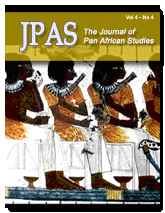ARCHIVED ISSUE
 Volume 4 • Number 4 • 2011
Volume 4 • Number 4 • 2011
On The Cover:
Ancient Kemet Alive.
 Get Adobe Reader now.
Get Adobe Reader now.
Its
the required viewer for these articles.
● Editorial: Skin Bleaching and Global White Supremacy
by Yaba Amgborale Blay and Christopher A.D. Charles
[ view PDF ]
● Skin Bleaching and Global White Supremacy: By Way of Introduction
by Yaba Amgborale Blay
[ view PDF ]
This introductory article critically examines the symbolic significance of whiteness, particularly for and among African people, by outlining the history of global White supremacy, both politically and ideologically, discussing its subsequent promulgation, and further investigating its relationship to the historical and contemporary skin bleaching phenomenon. The article also provides a broader socio-historical context within which to situate the global practice of skin bleaching, and provides a necessary framework for further realizing the critical significance of the articles presented in this issue.
● Skin Bleach and Civilization: The Racial Formation of Blackness in 1920s Harlem
by Jacob S. Dorman
[ view PDF ]
The author of this paper argues that for African Americans at the turn of the 20th century, skin bleaching represented much more than mere cosmetic practice. Examining historical archives, newspaper records, skin bleaching product advertisements, and the infamous and bitter wrangle between W.E.B. DuBois and Marcus Garvey, the author positions skin bleaching within the larger discourse of civilization and contends that the practice reflected ambiguous notions of racial progress and advancement.
● Visual Representations of Feminine Beauty in the Black Press: 1915-1950
by Amoaba Gooden
[ view PDF ]
In an examination of Black vanguard news reporting, this paper highlights the extent to which the Black press, influenced by White supremacy, patriarchy, and classism, assigned higher value to those ideals and physical features associated with Whiteness than those associated with Blackness. Given the frequent appearance of skin bleaching advertisements, and the extent to which reporters attempted to reject degrading popular images of Black women (e.g. the Mammy), the author argues that the Black press ultimately endorsed skin bleaching as a means through which Black women in particular could attain not only feminine beauty, but social respectability.
●Black No More: Skin Bleaching and the Emergence of New Negro Womanhood Beauty Culture
by Treva B. Lindsey
[ view PDF ]
An examination of a number of skin bleaching advertisements, focused specifically on late 19th to early 20th century Washington D.C. and skin bleaching among Washingtonian women. The author explores the relationship between White supremacy, skin bleaching, and New Negro womanhood, and in the final analysis she connects skin bleaching to a politics of appearance that intersected with White supremacist and gendered discourses about urban Black modernity and social mobility; and asserts that African American women of the time embraced a White constructed beauty culture as means to an end - social, political, and economic freedom.
● The Derogatory Representations of the Skin Bleaching Products Sold in Harlem
by Christopher A.D. Charles
[ view PDF ]
This work analyzes the images used to market skin bleaching products sold in contemporary Harlem in order to determine whether or not such imagery is derogatory. The author discovers that many of the underlying messages inherent to the imagery displayed on skin bleaching labels today are identical to those used decades ago in that they continue to exhibit hegemonic representations of Whiteness versus Blackness. In estimation of the author, it is this consistency and continuation that continues to push the sale of skin bleaching products in the United States.
● Buying Racial Capital: Skin Bleaching and Cosmetic Surgery in a Globalized World
by Margaret L. Hunter
[ view PDF ]
This contribution argues that the increased incidence of transnational skin bleaching is a result of the merging of old ideologies (colonialism, race, and color) with new technologies of the body (skin bleaching and plastic surgery). In this way, as one attains light skin, s/he attains a form of racial capital - a resource drawn from the body that provides tangible benefits within the context of White supremacy.
● From Browning to Cake Soap: Popular Debates on Skin Bleaching in the Jamaican Dancehall
by Donna P. Hope
[ view PDF ]
The article examines skin bleaching through the lens of dancehall music culture which, unlike the larger Jamaican society, contends that skin bleaching represents a mode of fashion and style. By examining dancehall artists, their public personas, and their lyricism about skin bleaching, and further situating skin bleaching within Jamaica's historically three-tiered racialized society, the author attempts to unpack conflicting cultural debates surrounding skin bleaching in Jamaica.
● Shona Proverbial Implications on Skin Bleaching: Some Philosophical Insights
by Ephraim Taurai Gwaravanda
[ view PDF ]
This paper examines the phenomenon of skin bleaching from a cultural perspective and argues that Shona proverbs (in Zimbabwe) are part of wise sayings that can be used to overcome the dilemmas, contradictions and uncertainties of skin bleaching. The research is theoretically grounded in the Afrocentric theory that defends African value systems and critiques global white supremacy.
● Commentary: On Skin Bleaching and Lightening as Psychological Misorientation Mental Disorder
by Daudi Ajani ya Azibo
[ view PDF ]
This commentary argues that skin bleaching is consistent with the psychological misorientation mental disorder articulated in Azibo Nosology. Thus, living under White domination has severely traumatized people of African descent and has destabilized people of African descent of the ability to psychologically orient themselves. Skin bleaching is thus regarded a reflective side effect of psychological destabilization.



